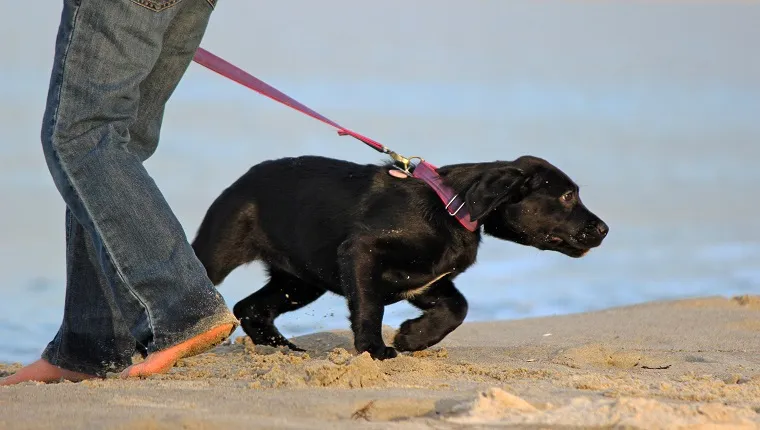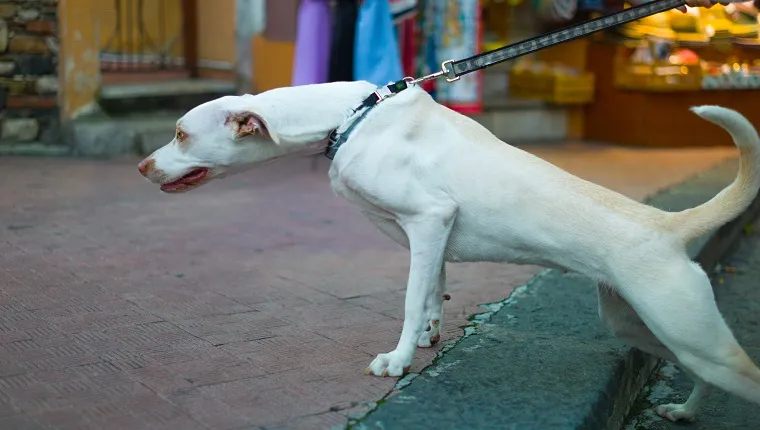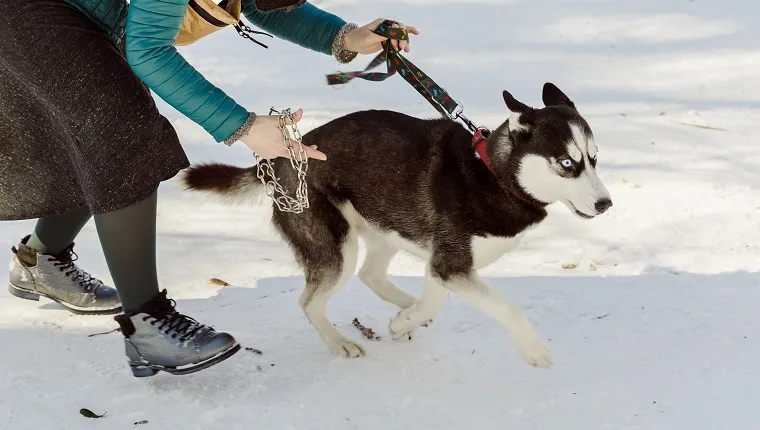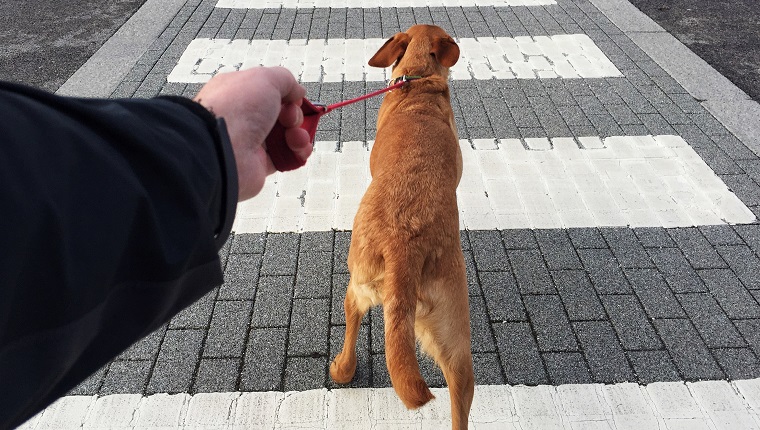Pulling on the leash is a common problem, hence the old “Who’s walking who?” joke. And many of us unknowingly perpetuate it by letting ourselves be dragged along like a hooked fish.
So how do you stop it? First, stop rewarding the behavior.
Whether it’s a new puppy or an older dog, never let your dog or pup get anywhere they’re pulling. You’re walking them, not the other way around.
Here are a few things you should know about leash training your dog to get rid of that pulling habit.
Why Is Your Dog Pulling?
An energetic dog pulls because they’re eager to go, go, go.
A curious pup lunges toward a fascinating dog, person, shrub, butterfly, or whatever grabs their attention. A nervous pooch may drag you home in their eagerness to get back to the safety of their own turf.
There are many reasons dogs pull, but they all boil down to this: dogs pull because we let them. If the walk continues — or even speeds up — when your dog forges ahead, they’ll keep pulling.
How To Prevent Pulling With Puppies

This exercise, from master trainer and DogTime contributor Ian Dunbar, helps teach puppies good leash manners. Pick a quiet place free of tempting distractions to practice leash training, usually indoors or in a fenced area.
- 1. Leash your pup and stand still with the leash close to your body, and wait for the puppy to stop leaping around. It may take a while, but eventually their antics will subside. As soon as your pup settles and lies or sits down, praise them, give them a treat, and tell them, “Let’s go.” Take one step forward and stand still.
- 2. Wait for your puppy to settle down. As soon as they do so, praise them, give them a treat, tell them again, “Let’s go,” and take another step, repeating the whole sequence. Each time, have the pup stay in the sit or down position for a few seconds longer before they get the treat and the “walk” resumes.
- 3. Reward them with longer walks. Once your pup is able to go on these one-step walks without pulling, you can start taking two steps. When your pup has mastered two steps without pulling, move on to three steps, and so on. Eventually you should be able to walk together with a loose leash, and the pup will sit or lie down when you stop.
How To Treat The Problem With Adult Dogs
If you need to teach your older dog how to behave on leash, try the following:
- Change direction. Hold the leash close to your side, so the dog has just a few inches of slack, and start walking. Whenever the dog pulls in any direction, go the opposite way. If they lunge ahead, turn around and walk in the reverse direction. If they pull left, turn right, and so on. Don’t jerk on the leash, just smoothly change direction. Your dog will realize that if they don’t want to be left behind, they need to stick close to your side.
- Plant yourself. Walk forward with your dog on-leash. The moment they start to pull and the leash tightens, turn into a tree — that is, plant your feet and don’t budge. Call their name and walk back a few steps until they move toward you. Reward them with a treat, and start walking again. The second they pull on the leash, stop again.
Common Mistakes

Make sure you’re avoiding these common pitfalls:
- Letting the walk continue. If you keep walking, you’re rewarding your dog for lunging ahead. If you speed up, you give them a bonus reward — they get to go where they want to even faster.
- Pulling back on the leash. Most dogs respond to the pressure by pulling even harder.
- Using a retractable leash. These leashes teach the dog that when they pull, they go further — not a good lesson for a puller. Put the retractable leash away until your dog learns good leash manners.
Halters & Harnesses
A number of collars, halters, and harnesses are designed to discourage dogs from pulling. Use these with caution and in conjunction with leash training.
These products may help, but don’t expect them to immediately solve your dog’s pulling problem. They’re also not right for every dog, so make sure to research and test them first.
- Head halter (also known as a head collar): The halter looks kind of like a muzzle, but it’s designed to stop pulling, not biting. When your dog barges ahead, the tension on the halter’s noseband will turn their head to the side. If the dog wants to look — and walk — straight ahead, they must walk on a loose leash. A head halter may be a good choice for a dog who pulls so hard they choke or cough, since it doesn’t put any pressure on the windpipe. Because of the noseband, the head halter can’t be used on dogs with very short noses, such as pugs. And while puppies usually get used to a head halter quickly, many adults will fight it.
- Harness: Harnesses designed to stop pulling go around the dog’s chest and shoulders, and the leash attaches to a ring on the front of the dog’s chest. As with the halter, the idea is that when the dog pulls, they’ll be turned to the side. Be careful when you’re shopping for harnesses; some attach to the leash on the dog’s back, rather than the chest, which can exacerbate a pulling problem.
Beware Of Potentially Dangerous Products To Discourage Pulling

Some products meant to discourage pulling can actually hurt your dog, especially if they’re used incorrectly. DogTime does not recommend these products, and you should consult a professional trainer before considering using them.
- Choke collar: Choke collars tighten around the dog’s neck when the human pulls the leash. Many trainers don’t like them because they cause pain and can injure the dog’s windpipe, neck, or spine. And if they get caught on something, your dog can choke to death. If the chain isn’t threaded through the rings correctly, it will continue choking your dog even when you’ve released the tension on the leash.
Warning: You should never use a choke collar on puppies, dogs without thick neck fur, dogs with a respiratory problem, or breeds with fragile windpipes, such as Chihuahuas or Yorkshire Terriers because you could easily injure your dog.
- Prong/Pinch collars: As their name suggests, these collars have metal prongs on the underside of the collar that will dig into the dog’s neck when you pull on the leash. Because they hurt the dog, many trainers don’t recommend them.
You can cure your dog of a pulling habit without using painful collars, but it takes time, patience, and an unwavering commitment to the golden rule of good leash manners: never, ever let your dog get anywhere when they’re pulling.
If your dog barges ahead, stop and wait for the leash to go slack, or change direction quickly so your dog learns to stick closer to you.
Have you trained your dog not to pull on their leash? What are your leash training tips for fellow dog parents? Let us know in the comments below!









